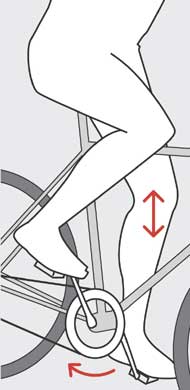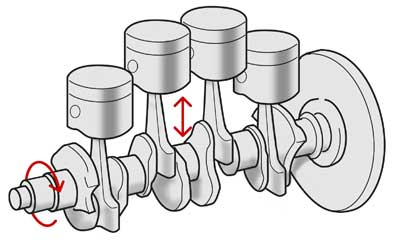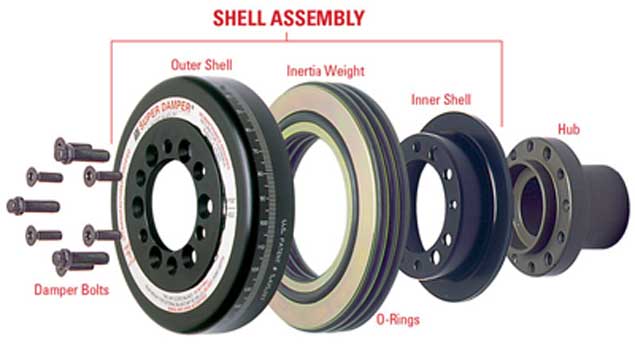(Article
begins on the Tech, Tests & Installs page HERE)
Sometimes
there are only two, four, or, on newer engines, six main
caps that go over the crankshaft and then bolt to the
actual engine block. This keeps your crankshaft where
it should be. Finally, you have the rods, pistons, wristpins
and rings. This is where all of the crankshaft twist and
harmful “harmonics” are truly started.
 Your
pistons and components have to travel up and down the
cylinder, to the top of the motor and then to the bottom.
If you think about that motion within a motor, something
has to be off the centerline of the crankshaft so that
as the crankshaft turns one revolution, a piston is pushed
to the top and then pulled to the bottom. However, if
that stroke is a firing stroke, where fuel is compressed
and combusted, that piston is then also forced downward
and that is what actually produces your power. Think
about riding a bicycle and the way you pedal the bike
to move. The pedals themselves are like the pistons
and the rod between the pedal and the crank sprocket is
just like your connecting rods. The pedal arms have to
be off the centerline of the crank in order for you to
make a circle with the pedals and move your bike forward.
Your crankshaft and pistons can be viewed in the same
light. Because something has to be off the centerline
of the crankshaft in order to function, the leverage of
that connection to the crank is very high. That is why
the crankshaft will twist as the system is forced to rotate
when the engine is fired.
Your
pistons and components have to travel up and down the
cylinder, to the top of the motor and then to the bottom.
If you think about that motion within a motor, something
has to be off the centerline of the crankshaft so that
as the crankshaft turns one revolution, a piston is pushed
to the top and then pulled to the bottom. However, if
that stroke is a firing stroke, where fuel is compressed
and combusted, that piston is then also forced downward
and that is what actually produces your power. Think
about riding a bicycle and the way you pedal the bike
to move. The pedals themselves are like the pistons
and the rod between the pedal and the crank sprocket is
just like your connecting rods. The pedal arms have to
be off the centerline of the crank in order for you to
make a circle with the pedals and move your bike forward.
Your crankshaft and pistons can be viewed in the same
light. Because something has to be off the centerline
of the crankshaft in order to function, the leverage of
that connection to the crank is very high. That is why
the crankshaft will twist as the system is forced to rotate
when the engine is fired.
 While
your motor is running, you have some pistons that are
being pushed downward on a power stroke, some that are
being pulled down by the crankshaft, and then there are
some that are being pushed upward by the crankshaft. Now
think about this entire system happening 8,000+ times
per minute! Even further, think about all of these different
actions that are taking place, and then imagine them happening
on the same piece of metal - the crankshaft. These actions
make that shaft twist in one direction away from its natural
home location, and then when it tries to come back to
that home location, its momentum makes it travel past
its original location and farther in the other direction.
This is what I measure when damper testing and the measure
magnitude of that action is, Degrees of Twist –
Peak to Peak. That is called crankshaft twist. That is
what breaks parts and robs you of horsepower when there
is nothing to counteract and eliminate the twist. In this
system, the worst torsional vibrations, or twist, will
always occur at the farthest point from the greatest load,
or the heaviest mass. A torsional twist is defined as
a twist without a bend. If you get too much of this twist,
you will have a bend and this will cause engine and or
crank failures. Think about twisting a piece of rope over
and over, you can make one or two revolutions and nothing
happens. Then after that it starts to get a wave in it,
and then as you twist more, the rope will pull your hands
closer together.
While
your motor is running, you have some pistons that are
being pushed downward on a power stroke, some that are
being pulled down by the crankshaft, and then there are
some that are being pushed upward by the crankshaft. Now
think about this entire system happening 8,000+ times
per minute! Even further, think about all of these different
actions that are taking place, and then imagine them happening
on the same piece of metal - the crankshaft. These actions
make that shaft twist in one direction away from its natural
home location, and then when it tries to come back to
that home location, its momentum makes it travel past
its original location and farther in the other direction.
This is what I measure when damper testing and the measure
magnitude of that action is, Degrees of Twist –
Peak to Peak. That is called crankshaft twist. That is
what breaks parts and robs you of horsepower when there
is nothing to counteract and eliminate the twist. In this
system, the worst torsional vibrations, or twist, will
always occur at the farthest point from the greatest load,
or the heaviest mass. A torsional twist is defined as
a twist without a bend. If you get too much of this twist,
you will have a bend and this will cause engine and or
crank failures. Think about twisting a piece of rope over
and over, you can make one or two revolutions and nothing
happens. Then after that it starts to get a wave in it,
and then as you twist more, the rope will pull your hands
closer together.
 Once
these vibrations get to the front of the motor, something
there needs to counteract that motion. That is where the
damper comes into play. The damper’s job is to absorb
and counteract as much of the twist as it possibly can.
If you have the right damper on your motor, almost all
of the twist can be eliminated. However with the wrong
damper virtually all of the twist can remain. A damper's
job is to rebound, the recoil of a spring. In this case
the spring is your crankshaft twisting and when it tries
to rebound past that natural state we discussed earlier,
that is when the damper needs to stop it.
Once
these vibrations get to the front of the motor, something
there needs to counteract that motion. That is where the
damper comes into play. The damper’s job is to absorb
and counteract as much of the twist as it possibly can.
If you have the right damper on your motor, almost all
of the twist can be eliminated. However with the wrong
damper virtually all of the twist can remain. A damper's
job is to rebound, the recoil of a spring. In this case
the spring is your crankshaft twisting and when it tries
to rebound past that natural state we discussed earlier,
that is when the damper needs to stop it.
You
may be wondering what that has to do with HP? Remember
from above what is also at the front of your motor - your
camshaft drive. If the front of your crankshaft is twisting,
then your camshaft drive is being pulled and relaxed and
pulled as the snout of the crank twists. If your camshaft
position is being changed or varies, then the engine cannot
properly induce, combust and remove the fuel. That means
a loss in power!
You
must have a reliable damper that is capable of properly
combating these vibrations and twist. Your stock damper,
or stock style damper, is simply a piece of soft steel
that has a rubber ring that has been melted in between
another steel ring. The inherent problem with that design
is that there is no way to maintain concentricity of the
inertia ring during manufacturing. Therefore, the damper
has to be machined and balanced after the inertia weight
has been bonded to the rubber strip. That means when the
outer ring slips you lose your timing marks, damper balance
and concentricity! The stock damper works just fine as
long as you do not make many changes to the motor. When
you start changing HP and RPM you cannot count on your
stock damper to do its job. Not to mention if that damper
is old and worn out, the outer ring has a good chance
of slipping or even separating from the rest of the damper
and coming off your engine completely!
Many
different styles of aftermarket dampers are available.
Through many years of testing and tuning, the O-ring style
Elastomer damper has proven to be the best choice for
performance applications, especially when high RPM is
being applied. Additionally, this style is re-buildable
and even tunable for your particular engine. A good resource
for more in-depth research is an SAE paper called, "A
Practical Treatise on Engine Crankshaft Torsional Vibration
Control" by Robert C. Bremer Jr. (SAE Paper SP-445,
June 1979). An excerpt can be found at www.atiracing.com
HERE.

Aftermarket
ATI Super Dampers are available from 4 to 17 lbs, in steel
and aluminum, with serpentines, HTD, Gilmer, V groves,
magnets in the shell, teeth cut into a steel shell, or
just about anything you could ever want on them. These
dampers come in diameters of 5” to 8” and
thicknesses from 1.1” to 2.5”. One of the
biggest size challenges comes with the Import Car Market.
These small motors are making lots of HP and turning lots
of RPM and usually have huge cylinder pressures with turbos
blowing in 20+ lbs of boost! The stock Japanese dampers
are not any different than stock American dampers in design,
except for their size. The average size of the Import
stock damper is around 5-½ inches. Some import
dampers are VERY poorly attached with 4 bolts holding
the damper to a slip-on lower timing belt drive and the
“damper” bolt holding on that gear. Terrible
design for high performance and you are asking for trouble
if this is not addressed.
The biggest problem with a smaller damper is that you
have to be able to have enough inertia weight to make
the damper do its job. Think about your common “Power
Pulleys.” They may add some power by slowing down
all of your accessories, but they will hurt your engine
life and your power at some RPM ranges. Power Pulleys
are not the right way to make power! In the long run power
pulleys will yield failures in your engine and components
on your car, especially flywheel bolts coming off and
oil pump failures. That stands true for Imports and American
cars. Read more about the Dangers of Power Pulleys, at
www.atiracing.com HERE.
Hopefully,
this article has cast some light on crankshaft dampers.
They are not black magic, just something that most people
never think about. Chances are that your stock damper
is old, and that the rubber has started to crack and wear
out. Or you might have a cheaper aftermarket damper that
is nothing more than a polished up stock damper design.
Like I said, most people never check out their damper
because they never realized what a critical component
it is.





